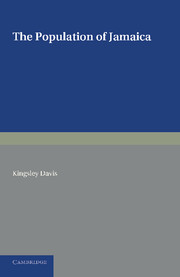Book contents
- Frontmatter
- The Conservation Foundation
- Contents
- List of Figures
- List of Tables
- Preface
- INTRODUCTION
- CHAPTER 1 DEMOGRAPHIC MATERIAL AVAILABLE
- CHAPTER 2 GROWTH OF THE POPULATION
- CHAPTER 3 MAJOR CHARACTERISTICS OF THE POPULATION
- CHAPTER 4 CURRENTS OF EXTERNAL MIGRATION
- CHAPTER 5 INTERNAL MIGRATION
- CHAPTER 6 MORTALITY
- CHAPTER 7 CHANGING PATTERNS OF REPRODUCTION
- CHAPTER 8 FERTILITY, MATING AND ILLEGITIMACY
- CHAPTER 9 GROWTH PROSPECTS
- APPENDICES
- Index of Names
- Index of Subjects
CHAPTER 5 - INTERNAL MIGRATION
Published online by Cambridge University Press: 05 June 2016
- Frontmatter
- The Conservation Foundation
- Contents
- List of Figures
- List of Tables
- Preface
- INTRODUCTION
- CHAPTER 1 DEMOGRAPHIC MATERIAL AVAILABLE
- CHAPTER 2 GROWTH OF THE POPULATION
- CHAPTER 3 MAJOR CHARACTERISTICS OF THE POPULATION
- CHAPTER 4 CURRENTS OF EXTERNAL MIGRATION
- CHAPTER 5 INTERNAL MIGRATION
- CHAPTER 6 MORTALITY
- CHAPTER 7 CHANGING PATTERNS OF REPRODUCTION
- CHAPTER 8 FERTILITY, MATING AND ILLEGITIMACY
- CHAPTER 9 GROWTH PROSPECTS
- APPENDICES
- Index of Names
- Index of Subjects
Summary
As has been shown in Chapter 2 there is evidence of a movement from the rural areas into Kingston as early as 1881. Indeed, the Committee which examined the conditions of the juvenile population of the island in 1880 reported: ‘We find that there is a tendency amongst portions of the rural population to gravitate towards the towns and Kingston especially. The class to which we refer are moved by a desire to obtain their livelihood by other means than agricultural labour, and by the hope of that casual employment at high rates which is often to be obtained in towns.’ This movement gathered momentum in the early years of the twentieth century and St Andrew developed as the suburban area of the capital. The one important current of internal migration in the past, the exodus of the ex-slaves from the sugar plantations after emancipation, differed in character, direction and dimensions from the recent urbanward drift. The early movement away from the plantations was basically a redistribution of the rural population, a flight from plantation life to small villages and independent settlements and not in any way parallel to the urbanward drift of modern times.
The census of 1943 was the first at which detailed information on the population by parish of birth was tabulated. This gives breakdowns by parish of residence and length of time persons not born in a parish lived in that parish. It is impossible to gain from these data exact figures of the numbers who moved from one parish to another. But they do furnish the basis for an analysis of the approximate dimensions and of the direction of internal migration over two periods: the first prior to 1921 and the second for the period 1921–43. It is here assumed that persons not born in their parish of residence but who lived in that parish for periods not exceeding 20 years entered it during the intercensal interval 1921–43. Similarly, persons not born in a parish but who lived in that parish for periods in excess of 20 years are assumed to have migrated some time prior to 1921.
- Type
- Chapter
- Information
- The Population of Jamaica , pp. 142 - 164Publisher: Cambridge University PressPrint publication year: 2013



